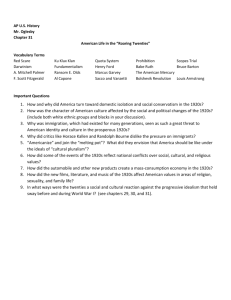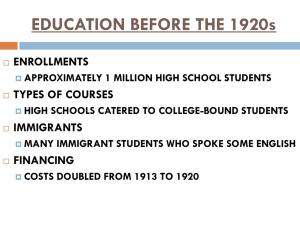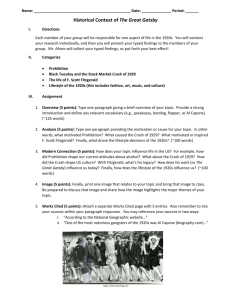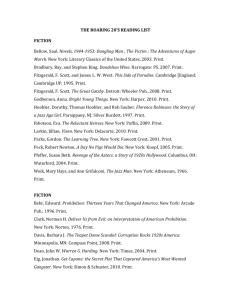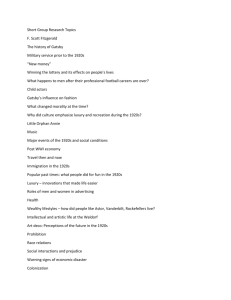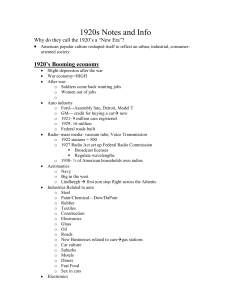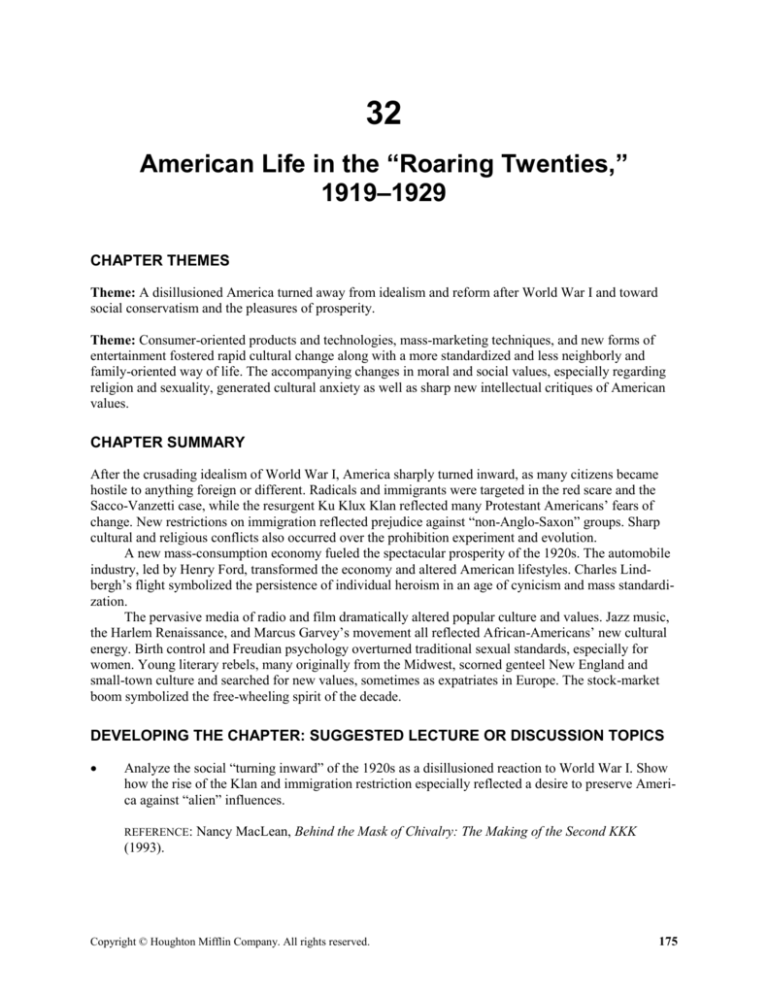
32
American Life in the “Roaring Twenties,”
1919–1929
CHAPTER THEMES
Theme: A disillusioned America turned away from idealism and reform after World War I and toward
social conservatism and the pleasures of prosperity.
Theme: Consumer-oriented products and technologies, mass-marketing techniques, and new forms of
entertainment fostered rapid cultural change along with a more standardized and less neighborly and
family-oriented way of life. The accompanying changes in moral and social values, especially regarding
religion and sexuality, generated cultural anxiety as well as sharp new intellectual critiques of American
values.
CHAPTER SUMMARY
After the crusading idealism of World War I, America sharply turned inward, as many citizens became
hostile to anything foreign or different. Radicals and immigrants were targeted in the red scare and the
Sacco-Vanzetti case, while the resurgent Ku Klux Klan reflected many Protestant Americans’ fears of
change. New restrictions on immigration reflected prejudice against “non-Anglo-Saxon” groups. Sharp
cultural and religious conflicts also occurred over the prohibition experiment and evolution.
A new mass-consumption economy fueled the spectacular prosperity of the 1920s. The automobile
industry, led by Henry Ford, transformed the economy and altered American lifestyles. Charles Lindbergh’s flight symbolized the persistence of individual heroism in an age of cynicism and mass standardization.
The pervasive media of radio and film dramatically altered popular culture and values. Jazz music,
the Harlem Renaissance, and Marcus Garvey’s movement all reflected African-Americans’ new cultural
energy. Birth control and Freudian psychology overturned traditional sexual standards, especially for
women. Young literary rebels, many originally from the Midwest, scorned genteel New England and
small-town culture and searched for new values, sometimes as expatriates in Europe. The stock-market
boom symbolized the free-wheeling spirit of the decade.
DEVELOPING THE CHAPTER: SUGGESTED LECTURE OR DISCUSSION TOPICS
Analyze the social “turning inward” of the 1920s as a disillusioned reaction to World War I. Show
how the rise of the Klan and immigration restriction especially reflected a desire to preserve America against “alien” influences.
REFERENCE:
Nancy MacLean, Behind the Mask of Chivalry: The Making of the Second KKK
(1993).
Copyright © Houghton Mifflin Company. All rights reserved.
175
176
Chapter 32
Discuss the Scopes trial as a focal point of the deep conflicts over religion and culture in the 1920s.
REFERENCE:
George Marsden, Fundamentalism and American Culture (1980).
Examine the economic and cultural consequences of the new mass-consumption economy. Show
how innovations such as credit buying, advertising, and automobile travel weakened the old
Protestant ethic with a new emphasis on pleasure and excitement.
REFERENCE:
Ronald Marchand, Advertising the American Dream: Making Way for Modernity
(1985).
Consider the radical cultural transformations in moral and sexual values brought about by such developments as movies, birth control, Freudian psychology, jazz, and “advanced” literature, especially as they affected women. Examine the rise of the “consumer culture” and its impact on
traditional moral and social values (e.g., the impact of credit buying on the “Puritan ethic”).
REFERENCE:
Stanley Coben, Rebellion Against Victorianism: The Impetus for Cultural Change in
1920s America (1991).
FOR FURTHER INTEREST: ADDITIONAL CLASS TOPICS
Explore the ideology and actions of the 1920s Klan. Consider similarities and differences in relation
to the Klan of Reconstruction.
Discuss the role of prohibition during the 1920s and its close relation to the rise of organized crime.
Explore the complex and sometimes contradictory cultural values of the decade as symbolically
represented by Charles Lindbergh’s flight. Discuss how he symbolized technological innovation but
also individual heroism in an increasingly “mass” society.
Consider the role of both black and white artists in changing American culture in the 1920s. Consider where writers like Fitzgerald and Hughes were reflecting similar concerns, and where their
outlook was different.
CHARACTER SKETCHES
Henry Ford (1863–1947)
Ford was the automobile genius and industrialist who epitomized the new age of mass consumer production.
Although he hated farm work as a boy, Ford was always nostalgic about rural life and later recreated an idealized version of it in his Greenfield Village.
He was widely praised for paying his workers $5 a day—although not all of them earned that. In
1915, Ford paid for a “Peace Ship” full of American antiwar activists who sailed to Norway in a futile
effort to end World War I. In the 1920s he published a viciously anti-Semitic paper, The Dearborn Independent, which was distributed through Ford dealerships.
Copyright © Houghton Mifflin Company. All rights reserved.
American Life in the “Roaring Twenties,” 1919–1929
177
Ford enjoyed his own reputation as the voice of the uneducated common person and often sounded
off on subjects about which he knew nothing. For example, he asserted that earlier civilizations had had
airplanes and cars, that cows should be eliminated and milk produced artificially, and that all the art in the
world was not worth five cents.
Quote: “I don’t like to read books. They mess up my mind.” (1919)
REFERENCE:
David L. Lewis, The Public Image of Henry Ford (1976).
Alphonse Capone (1899–1947)
Capone was the brutal gangster who dominated Chicago organized crime in the late 1920s and early
1930s.
Capone’s parents were Italian immigrants from Sicily who came to New York in 1893. Capone quit
school after the fourth grade and soon linked up with other gang members, including Johnny Torrio. In
one early gang fight Capone was slashed across the face with a knife, giving him his nickname of
“Scarface.”
When Torrio moved from New York to Chicago, Capone followed him to help run the giant prostitution operation and other rackets in the city. In 1925 Torrio retired, and Capone seized control of all of
Chicago’s prohibition-era organized crime by gunning down his rivals. Capone’s worth was estimated at
over $100 million and for a time in the late 1920s he had extensive power within Chicago’s political,
journalistic, and law-enforcement communities.
After his conviction for income-tax evasion and imprisonment on Alcatraz Island, he was discovered to be suffering from syphilis. He was released on parole in 1939.
Quote: “What’s your racket?” (1927)
REFERENCE: John Kobler, The
Life and World of Al Capone (1992); Laurence Bergreen, Capone: The
Man and the Era (1994).
Charles A. Lindbergh (1902–1974)
Lindbergh was the pilot whose solo flight made him the greatest hero of the 1920s and who later became
a leading isolationist spokesman before World War II.
A group of St. Louis businessmen put up the money for Lindbergh’s plane, which had never been
fully tested before he headed across the Atlantic. He dozed off several times during the flight but was
awakened each time by the erratic movements of the plane. Vast crowds greeted him in Paris, although he
landed in the dark.
Lindbergh was stunned by the unrelenting publicity and tried unsuccessfully to withdraw from the
public eye. He married the daughter of diplomat Dwight Morrow. Anne Morrow Lindbergh later became
a popular author. The kidnapping and murder of their two-year-old son in 1932 horrified America and
caused the Lindberghs to move to Europe. Lindbergh’s association with Nazism and isolationism in the
1930s cost him some popularity, but he sometimes advised the government on aviation matters even into
the 1950s and 1960s.
Copyright © Houghton Mifflin Company. All rights reserved.
178
Chapter 32
Quote: “These wars in Europe are not wars in which our civilization is defending itself against some Asiatic intruder.…This is not a question of banding together to defend our white race against foreign invasions. This is simply one more of those age-old quarrels among our family of nations.” (Radio address,
1939)
REFERENCE:
Scott Berg, Lindbergh (1998).
Marcus Garvey (1887–1940)
Garvey was the black nationalist leader whose “Back to Africa” movement had a major influence on African-American culture in the 1920s.
Garvey was born in Jamaica and worked as a printer and union organizer. During travels to South
America and Britain, he learned a great deal about the history and culture of African peoples, which led
him to emphasize black racial pride and to formulate his plans for a return of all blacks to Africa.
His Universal Negro Improvement Association attracted tremendous support from American blacks
in the early 1920s, but the government of Liberia (where Garvey hoped to migrate) thought him a revolutionary plotter and withdrew support from his Black Star steamship lines. His conviction for fraud and his
deportation to Jamaica effectively ended his political career, but he remained a hero among many blacks
for his emphasis on African culture and self-determination.
Quote: “Never allow anyone to convince you of your inferiority as a man. Rise in your dignity to justify
all that is noble in your race.
My race is mine and I belong to it.
It climbs with me and I climb with it.
My pride is mine and I shall honor it.
It is the height on which I daily sit.”
(The Negro World, 1923)
REFERENCE: J.
Stein, The World of Marcus Garvey (1986).
F. Scott Fitzgerald (1896–1940)
Fitzgerald was the novelist whose literature and life symbolized and promoted the values of the “jazz age”
in the 1920s.
His father was from an old aristocratic Maryland family whose ancestors included the author of
“The Star-Spangled Banner.” His mother was from a poor Irish background, and Fitzgerald claimed his
dual ancestry gave him a unique view of American life.
At Princeton, Fitzgerald worked harder for social than academic success and was distressed when
academic probation forced him to give up his campus literary activities. Fitzgerald’s glamorous postwar
life in Europe fell victim to lavish spending, alcoholism, and the mental illness of his wife Zelda.
In the 1930s he returned to America and wrote Tender Is the Night (1934) and a brilliant story,
“The Crack-Up,” about his own mental distress and feared loss of talent. When he was sober, Fitzgerald
was charming, elegant, and a fine conversationalist.
Copyright © Houghton Mifflin Company. All rights reserved.
American Life in the “Roaring Twenties,” 1919–1929
179
Quote: “America was going on the greatest, gaudiest spree in history.…The whole golden boom was in
the air—its splendid generosities, its outrageous corruptions, and the death struggle of the old America in
prohibition.” (1935)
REFERENCE: William A.
Fahey, F. Scott Fitzgerald and the American Dream (1973).
MAKERS OF AMERICA: THE POLES
Questions for Class Discussion
1. How did both economic and religious factors contribute to Polish immigration?
2. How was the Polish influence in America similar to that of other “New Immigrants” such as the Italians (see Chapter 25)? How was it different?
Suggested Student Exercises
The text lists five cities that were centers of Polish immigration to America: Chicago, Buffalo,
Pittsburgh, Detroit, and Milwaukee. Examine the impact of Polish-Americans in one of these cities
over several generations.
Critically analyze negative cultural stereotypes of Polish immigrants in the press and elsewhere in
the 1920s and after. Consider what biases may underlie these stereotypes, and how some of the social and cultural changes in recent decades, in both the United States and Poland (e.g., the Polish
Pope John Paul II and the fall of communism), may work to undercut such stereotyping.
QUESTIONS FOR CLASS DISCUSSION
1. Why did the United States, which had welcomed so many millions of immigrants for nearly a century, suddenly become so fearful of immigration in the 1920s that it virtually ended mass immigration
for two decades?
2. To what extent was the Scopes Trial only about competing theories of human origins, and to what
extent was it simply a focal point for deeper concerns regarding the role of religion and traditional
moral authorities in American life and the new cultural power of science?
3. Was the new “mass culture” as reflected in Hollywood films and radio a source of moral and social
change, or did it really reinforce the essentially conservative business and social values of the time?
(Consider the role of commercial advertising in particular.)
4. Were the intellectual critics of the 1920s really disillusioned with the fundamental character of American life, or were they actually loyal to a vision of a better America, and only hiding their idealism
behind a veneer of disillusionment and irony?
Copyright © Houghton Mifflin Company. All rights reserved.



